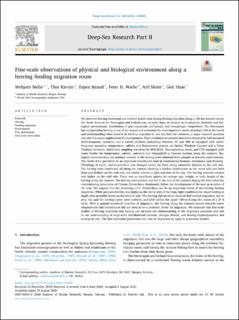| dc.description.abstract | We observed herring horizontal and vertical distribution during feeding migration along a 128 km transect across the Arctic front of the Norwegian and Iceland seas, in early June, in relation to its physical, chemical and biological environment, distribution of prey organisms and pelagic and mesopelagic competitors. The Norwegian Spring Spawning herring is one of the largest and economically most important stocks of pelagic fish in the world and understanding what controls its feeding migration is, and has been for centuries, a major research question that also has major implications for management. High resolution ecosystem data were obtained by hull mounted multi-frequency acoustics and a towed platform undulating between 10 and 400 m equipped with multi-frequency acoustics, temperature, salinity and fluorescence sensors, an Optical Plankton Counter and a Video Plankton Recorder. Additional sampling was done by MOCNESS, Macroplankton trawl, and CTD equipped with water bottles for temperature, salinity, nutrients and chlorophyll at discrete stations along the transect. Biological characteristics and stomach content of the herring were obtained from samples at discrete trawl stations. The Arctic front proved to be an important transitional zone in zooplankton biomass, abundance and diversity. Phenology of phyto- and zooplankton also changed across the front, being somewhat delayed on the cold side. The herring were distributed all along the transect showing a shallow distribution on the warm side and both deep and shallow on the cold side, not clearly related to light and time of the day. The herring stomach content was higher on the cold side. There was no significant pattern in average age, weight, or body length of the herring along the transect. The herring were present and fed in the area of the transect during the time when the overwintering generation of Calanus finmarchicus dominated, before the development of the new generation of the year. We suggest that the phenology of C. finmarchicus can be an important driver of the herring feeding migration. While prey-availability was higher on the Arctic side of the front, light conditions for visual feeding at depth were probably better on the Atlantic side. The herring did not show classical dial vertical migration, but its prey did, and the herring's prey were probably available within the upper 100 m during the course of a 24 h cycle. With a general westward direction of migration, the herring along the transect moved towards lower temperatures and temperature did not seem to be a probable driver for migration. We conclude that fine-scale studies of herring migration and feeding can increase our understanding of the migratory processes and add to our understanding of large-scale distributional patterns, changes therein, and herring trophodynamics and ecological role. The fine-resolution parameters can also be important as input to ecosystem models. | en_US |
